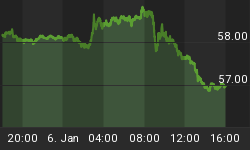Friday was a lethargic day, with gorgeous weather producing in many market participants a justification for leisure running something like this: Europe is having a conference call over the weekend about Spain and Spanish banks, and Spain is supposed to be formally requesting aid. As of the announcement on Saturday afternoon, we might have an entirely new set of rules. So why take any risk on Friday?
You have to admit, they have a point.
Not being as predisposed to such leisure, since I am an entrepreneur, I am writing an article today. Actually calling it an 'article' may be strong; actually, it's a compilation of some random thoughts that didn't make it into my articles this week.
.
- One commenter asked what the chart of the "hypothetical S&P price history" that I showed in yesterday's article would look like in real space. He hypothesized that we are probably a long way away from a real high. Well, DougM, you're right. The chart is below. Note that this is just the price index, so that your real total return would be essentially the price change on this chart, plus dividends...which works out, you can see, to basically dividends although if we ignore the first little dip to get us from the red line to the blue line, it works out to be something like 0.75% per annum real return (plus dividends). And yes, it will be a very long time until we party like it's 1999.

-
Earlier this week, I wrote that the "Inflation Risks [Are] More Balanced, But Not By Much." But I wasn't clear about what I see as the central tendency, which is to say what I think will happen to inflation "probably." Core inflation is rising in the U.S., U.K., Europe, and Japan, and in my view there is every reason to expect that trend to continue. The driver of that inflation, which is to say hearty money growth, remains in place. It wasn't growth that was pushing inflation higher - so the ebbing of that growth is not important to my view. I still expect core inflation to continue rising this year from the current 2.3% in the U.S.
-
What should the Fed do, if it can't reduce rates any more and is reluctant to expand the balance sheet further? Well, if I was at the Fed and I wanted to stimulate the economy, the first thing I would do before going out and buying more powder would be to ignite the powder I've already bought. The FOMC should simply remove the Interest on Excess Reserves (IOER), which has contributed to the huge scale of excess reserves. In fact, ideally they would penalize excess reserves. If the Fed set IOER at -3%, you would see aggressive lending from the banking sector. Yes, many of them would be non-economic loans (if the bank can lock in only a 2% loss after the inevitable defaults, it is worth doing), but you would get loans. The Fed doesn't want to do that because they think it will crush the money market industry. Well, exactly how well is the money-market industry doing at the moment anyway? Sure, you have to choose which bad effect you want, but don't whine about running out of tools just because you think the money market industry is more important than the proper conduct of monetary policy.
-
This is an old story, but it just goes to show you that when real interest rates are below zero, any commodity becomes a good store of value. Apparently the Procter & Gamble brand of detergent Tide is being used in some neighborhoods as a medium of exchange and store of value - that is, as money. The articles pooh-pooh the stories of Tide heists, but to me that's not the interesting question. If real interest rates were, say, 3%, or nominal interest rates were 5% or 6%, then the use of bottles of Tide as currency would make much less sense since they will always have a 0% real return over time (just like a bar of gold or a roll of copper wire) and you would lose real purchasing power by putting Tide, lumpily, under your mattress. But when real interest rates are -1%, Tide actually outperforms - as should all commodities. This is one reason why commodities normally do very well when real interest rates are low.
-
Corporate bond issuance is a long-inflation bet. If corporate treasurers believed there would be deflation, they'd issue inflation-linked bonds. The complete lack of inflation-linked bonds despite incredibly low real rates represents a bet that company CFOs are making that inflation will be higher in the future than it is expected to be now, based on the difference in fixed yields compared to inflation-linked yields. Or, it might represent ignorance, since if the market-clearing price for inflation is fair then we should see a much more balanced pattern of issuance with some issuers favoring ILBs and some favoring nominal bonds. But either way, it is certainly not a strong endorsement for the deflationary view - in a deflation, the last thing you want to do is issue fixed rate bonds.
-
If you own XYZ company, and the firm suddenly doubles its share count, each share of XYZ should roughly halve in price (and therefore buy half as much in exchange). We say in that case that you have been diluted. Now consider that the dollar itself is like a share of America, in that it entitles you to a certain amount of output of other people's goods and services. What do you think should happen when your shares are "diluted" because the Fed has increased the "share count" by 27% over the last four years? Shouldn't those shares buy less in exchange? That's called inflation. If you don't have 27% more dollars now than you did in June of 2008, then you have been diluted. And deluded.
Have a nice weekend.
















